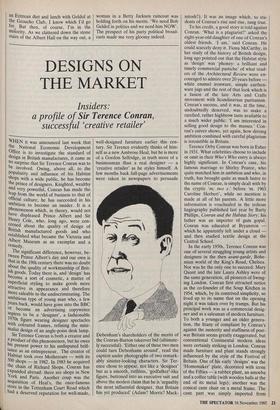FASHION FOR AID
Nicholas Coleridge on
the resistible charm of Bob Geldof
The Albert Hall FASHION Aid last week was the eighth Aid to date, following on from Band Aid, Live Aid and sundry School Aids, Lights Aid and Actors Aid. Coming shortly, no doubt, is Hearing Aid — deaf people against famine — and Marital Aid, when dozens of prostitutes will donate their night's takings and Ann Summers will be airlifted into Tigre with Bob Geldof and Harvey Goldsmith. Fashion Aid mean- while raised another million for the Ethio- pian famine appeal by the clever and glamorous idea of staging a hugh fashion show in the Albert Hall, featuring work by 18 designers, each competing to produce the most spectacular tableau and star models. So as well as the usual, gamin mannequins, there was the pop group Madness, and Jerry Hall who sprang out of a parcel, and Grace Jones and Selina Scott, and Michael Caine and Anthony Andrews who looked slightly silly, and Shirley Bas- sey and Miss World and Patrick Duffy of Dallas, as well as numerous lookalikes such as 12 Tina Turners and the Prime Minister.
It was moving, in the same way as certain patriotic Sunday afternoon films: the long, the short and the tall of the fashion industry burying the needle for one even- ing to raise money for Africa. Designers like Katherine Hamnett chose their models from every ethnic group — Jamaicans, Greeks, Thais, Hawaiians, Rastas — who danced and jived wonderfully, like the carnival in Rio.
It was interesting to see the spectrum of world fashion, from Boy George to Boy Mulcaster, condensed into three hours. Few of the clothes were of the kind liable to be worn by Spectator readers, particular- ly the British clothes, though I suppose Jean Muir and certain outfits by Bruce Oldfield and Margaret Howell might find their way into the mahogany tallboy. The remarkable diversity of fashion designs has been a cliché for ages, but seen one after the other still reemed bizarre: bland Calvin Klein, the world's richest designer, like a bad side-window in Selfridges; the strange Smurf-like hats designed by Stephen Jones for Jasper Conran; Rifat Ozbek's matelots, a cross between Cocteau and the Voici la France textbook; the hideous Emmanuels; as well as beatniks who loaned about in strobe lights like people used to do at Hampshire teenage parties; and Alpine ski jerseys, and Giorgio Armani's nouveaux riches frocks.
Several designers were at pains to score humanitarian points, even absent desig- ners. 'Calvin regrets he is unable to be here this evening,' read Mariel Hemingway from a postcard, 'but asks me to convey his deep commitment to world hunger.' The Duchess of Gloucester waved a tee-shirt proclaiming 'Let's Stop Children Dying'. Yes, and why stop there? 'Save the World' was on Katherine Hamnett's banners.
Which brings us to Bob Geldof. He came on at the end, obstreperous and crumpled in an understated 'Save Lives' tee-shirt, and everyone applauded and cheered him for being such a marvellous chap. This enraged Geldof. 'I want you to stand up and stay up,' he shouted, 'and give me yer fockin money. Give me yer fockin money.' The fashion victims sitting around me in the balcony, in their Body Map leggings and Culture Shock Zouave trousers, looked seriously nonplussed and cowered behind the parapet. Hectoring and ranting are new to the catwalk. 'Give me yer fockin money. Come on, give it to me now.' Geldof glowered around the great auditorium where everyone tried to avoid his eye, as one avoids the gaze of a drunk on the tube. What Geldof reminds me of most, however, is some megloma- niac school athletics captain who has deter- mined to bully the whole house into completing the cross country run, and doesn't mind how much distress he causes because it's a means to an end. The way that Geldof embarrassed a poor PR girl from Calvin Klein, whose only sin was reminding him to mention the designer in his vote-of-thanks, was indefensible. The problem of criticising Geldof is the certain- ty of sounding churlish, like chiding Mother Theresa for her table manners or Albert Schweitzer for illegible handwrit- ing. After the Princess of Wales, Geldof must be the most deified person in the land, what with his near-miss for the Nobel Peace Prize and his investiture by General Sowar Dohab of Sudan with the Order of the Two Niles (Second Class). Neverthe- less, given the choice between a month on an Eritrean diet and lunch with Geldof at the Groucho Club, I know which I'd go for. But then, of course, I'm in the minority. As we clattered down the stone stairs of the Albert Hall on the way out, a woman in a Betty Jackson raincoat was holding forth on his merits. 'We need Bob Geldof in politics and we need him NOW'. The prospect of his party political broad- casts made me very gloomy indeed.



































































 Previous page
Previous page